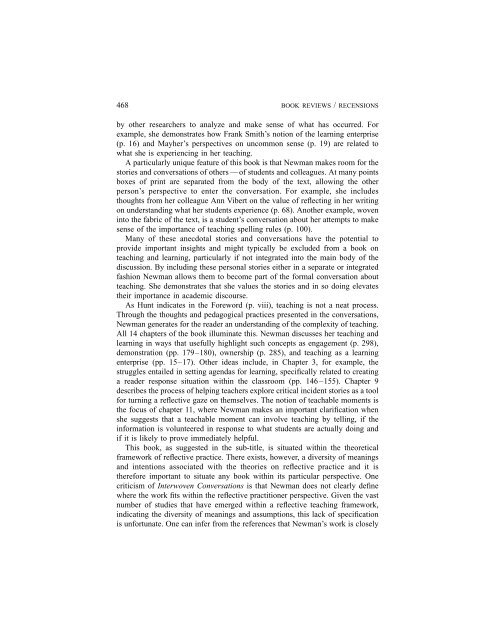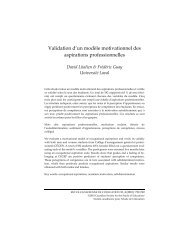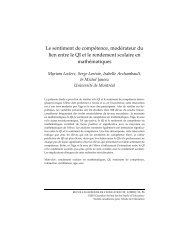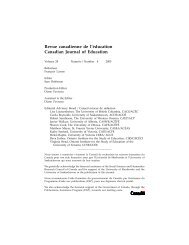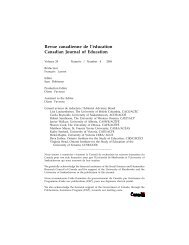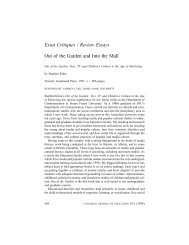Mireille Falardeau et Michel Loranger Le choix de stratégies ... - CSSE
Mireille Falardeau et Michel Loranger Le choix de stratégies ... - CSSE
Mireille Falardeau et Michel Loranger Le choix de stratégies ... - CSSE
You also want an ePaper? Increase the reach of your titles
YUMPU automatically turns print PDFs into web optimized ePapers that Google loves.
468 BOOK REVIEWS / RECENSIONS<br />
by other researchers to analyze and make sense of what has occurred. For<br />
example, she <strong>de</strong>monstrates how Frank Smith’s notion of the learning enterprise<br />
(p. 16) and Mayher’s perspectives on uncommon sense (p. 19) are related to<br />
what she is experiencing in her teaching.<br />
A particularly unique feature of this book is that Newman makes room for the<br />
stories and conversations of others — of stu<strong>de</strong>nts and colleagues. At many points<br />
boxes of print are separated from the body of the text, allowing the other<br />
person’s perspective to enter the conversation. For example, she inclu<strong>de</strong>s<br />
thoughts from her colleague Ann Vibert on the value of reflecting in her writing<br />
on un<strong>de</strong>rstanding what her stu<strong>de</strong>nts experience (p. 68). Another example, woven<br />
into the fabric of the text, is a stu<strong>de</strong>nt’s conversation about her attempts to make<br />
sense of the importance of teaching spelling rules (p. 100).<br />
Many of these anecdotal stories and conversations have the potential to<br />
provi<strong>de</strong> important insights and might typically be exclu<strong>de</strong>d from a book on<br />
teaching and learning, particularly if not integrated into the main body of the<br />
discussion. By including these personal stories either in a separate or integrated<br />
fashion Newman allows them to become part of the formal conversation about<br />
teaching. She <strong>de</strong>monstrates that she values the stories and in so doing elevates<br />
their importance in aca<strong>de</strong>mic discourse.<br />
As Hunt indicates in the Foreword (p. viii), teaching is not a neat process.<br />
Through the thoughts and pedagogical practices presented in the conversations,<br />
Newman generates for the rea<strong>de</strong>r an un<strong>de</strong>rstanding of the complexity of teaching.<br />
All 14 chapters of the book illuminate this. Newman discusses her teaching and<br />
learning in ways that usefully highlight such concepts as engagement (p. 298),<br />
<strong>de</strong>monstration (pp. 179–180), ownership (p. 285), and teaching as a learning<br />
enterprise (pp. 15–17). Other i<strong>de</strong>as inclu<strong>de</strong>, in Chapter 3, for example, the<br />
struggles entailed in s<strong>et</strong>ting agendas for learning, specifically related to creating<br />
a rea<strong>de</strong>r response situation within the classroom (pp. 146 –155). Chapter 9<br />
<strong>de</strong>scribes the process of helping teachers explore critical inci<strong>de</strong>nt stories as a tool<br />
for turning a reflective gaze on themselves. The notion of teachable moments is<br />
the focus of chapter 11, where Newman makes an important clarification when<br />
she suggests that a teachable moment can involve teaching by telling, if the<br />
information is volunteered in response to what stu<strong>de</strong>nts are actually doing and<br />
if it is likely to prove immediately helpful.<br />
This book, as suggested in the sub-title, is situated within the theor<strong>et</strong>ical<br />
framework of reflective practice. There exists, however, a diversity of meanings<br />
and intentions associated with the theories on reflective practice and it is<br />
therefore important to situate any book within its particular perspective. One<br />
criticism of Interwoven Conversations is that Newman does not clearly <strong>de</strong>fine<br />
where the work fits within the reflective practitioner perspective. Given the vast<br />
number of studies that have emerged within a reflective teaching framework,<br />
indicating the diversity of meanings and assumptions, this lack of specification<br />
is unfortunate. One can infer from the references that Newman’s work is closely


